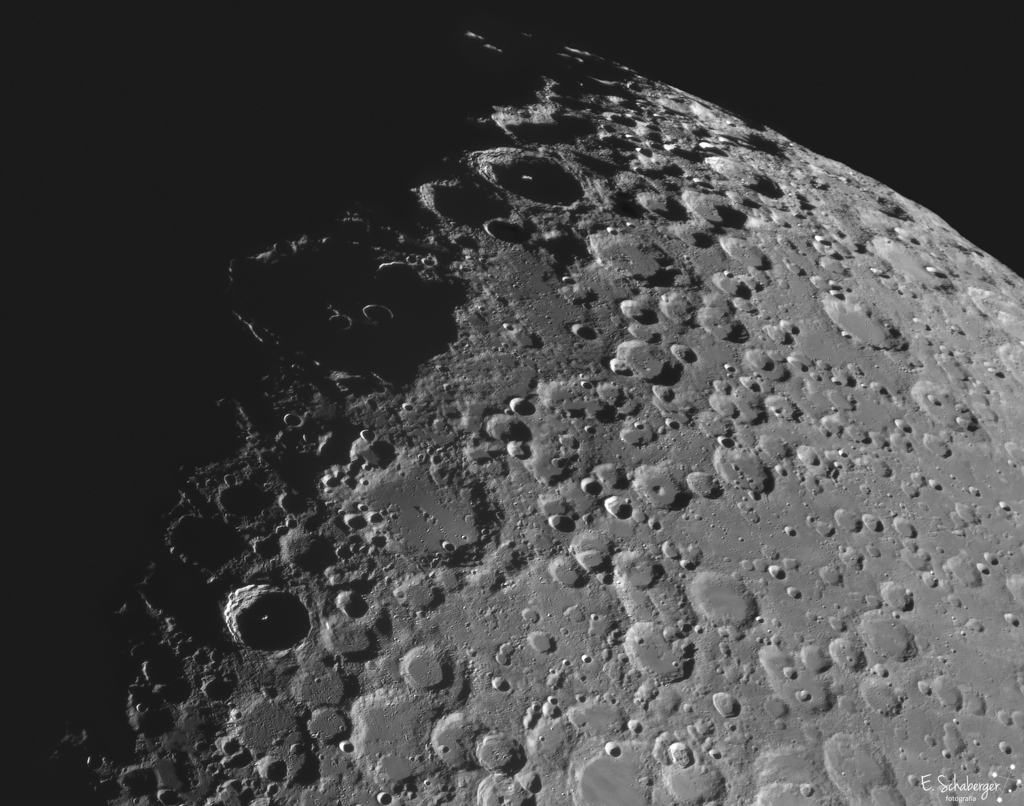안녕하세요!
디지탈노다지입니다.
미국 NASA에서 제공하는 오늘의 우주 사진을 공유합니다.
어떤 우주의 모습을 비춰줄까요?
우선, 사진부터 감상하시죠! 이 멋진 사진의 제목은 Tycho and Clavius at Dawn 입니다.
NASA에서 공식적으로 제공한 설명을 보시죠. South is up in this dramatic telescopic view of the lunar terminator and the Moon's rugged southern highlands. The lunar landscape was captured on July 7 with the moon at its first quarter phase. The Sun shines at a low angle from the right as dawn comes to the region's young and old craters Tycho and Clavius. About 100 million years young, Tycho is the sharp-walled 85 kilometer diameter crater below and left of center. Its 2 kilometer tall central peak and far crater wall reflect bright sunlight, Its smooth floor lies in dark shadow. Debris ejected during the impact that created Tycho make it the stand out lunar crater when the Moon is near full though. They produce a highly visible radiating system of light streaks or rays that extend across much of the lunar near side. In fact, some of the material collected at the Apollo 17 landing site, about 2,000 kilometers away, likely originated from the Tycho impact. One of the oldest and largest craters on the Moon's near side, 225 kilometer diameter Clavius is due south (above) of Tycho. Clavius crater's own ray system resulting from its original impact event would have faded long ago. The old crater's worn walls and smooth floor are now overlayed by newer smaller craters from impacts that occurred after Clavius was formed. Reaching above the older crater, tops of the newer crater walls reflect this dawn's early light to create narrow shining arcs within a shadowed Clavius. 달의 종착지와 달의 험준한 남쪽 고지대의 극적인 망원경으로 볼 수 있습니다. 달의 풍경은 7월 7일 달이 첫 4분의 1 단계에 있는 상태에서 포착되었다. 태양은 이 지역의 젊고 오래된 분화구인 티코와 클라비우스에 새벽이 오면 오른쪽에서 낮은 각도로 빛난다. 약 1억 년 정도 어린 티코는 중앙의 왼쪽 아래 85 킬로미터 직경의 날카로운 벽의 분화구이다. 그것의 2킬로미터 높이의 중앙 봉우리와 먼 크레이터 벽은 밝은 햇빛을 반사하고, 그것의 매끄러운 바닥은 어두운 그림자에 놓여 있다. 타이코를 탄생시킨 충돌 동안 분출된 파편들은 달이 거의 차 있을 때 티코를 눈에 띄는 달 크레이터로 만들었다. 그들은 달의 가까운 곳에 있는 많은 부분을 가로지르는 광선이나 광선의 매우 가시적인 방사 체계를 만들어낸다. 사실, 약 2,000 킬로미터 떨어진 아폴로 17호 착륙 지점에서 수집된 물질 중 일부는 타이코 충돌에서 비롯되었을 가능성이 있다. 달에서 가장 오래되고 큰 분화구 중 하나로 지름 225km의 크라비우스는 타이코 남쪽(위쪽)에 있다. 클라비우스 분화구의 자체 광선 체계는 원래 충돌로 인해 오래 전에 희미해졌을 것이다. 오래된 분화구의 마모된 벽과 매끄러운 바닥은 이제 클라비우스가 형성된 이후 발생한 충돌로 인해 더 새로운 작은 분화구가 덮였다. 오래된 분화구 위로 올라가면, 새로운 분화구 벽의 꼭대기가 오늘 새벽의 이른 빛을 반사하여 그늘진 클라비우스 안에 좁게 빛나는 호를 만듭니다. 우주의 다양한 모습은 아름답습니다~
그리고 광활하며 거대합니다. 형형색색 변화하며 살아있는 듯한 느낌을 주네요~ 가볼 수는 없지만 이렇게 사진으로 볼 수 있어서 좋네요!
디지탈노다지는 더 좋은 사진과 함께 돌아오겠습니다,
남은 하루도 행복하세요~ 
'자동화정보' 카테고리의 다른 글
| Stephan's Quintet from Webb, Hubble, and Subaru(2022-07-18)NASA 우주사진 (0) | 2022.07.18 |
|---|---|
| Europa and Jupiter from Voyager 1(2022-07-17)NASA 우주사진 (0) | 2022.07.17 |
| Lubovna Full Moon(2022-07-15)NASA 우주사진 (0) | 2022.07.15 |
| Webb's Southern Ring Nebula(2022-07-14)NASA 우주사진 (0) | 2022.07.14 |
| Webb's First Deep Field(2022-07-13)NASA 우주사진 (0) | 2022.07.13 |